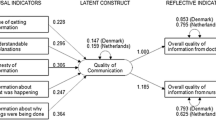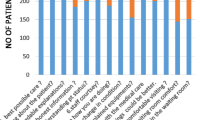Abstract
Purpose
To assess family satisfaction in the ICU and to identify parameters for improvement.
Methods
Multicenter study in Swiss ICUs. Families were given a questionnaire covering overall satisfaction, satisfaction with care and satisfaction with information/decision-making. Demographic, medical and institutional data were gathered from patients, visitors and ICUs.
Results
A total of 996 questionnaires from family members were analyzed. Individual questions were assessed, and summary measures (range 0–100) were calculated, with higher scores indicating greater satisfaction. Summary score was 78 ± 14 (mean ± SD) for overall satisfaction, 79 ± 14 for care and 77 ± 15 for information/decision-making. In multivariable multilevel linear regression analyses, higher severity of illness was associated with higher satisfaction, while a higher patient:nurse ratio and written admission/discharge criteria were associated with lower overall satisfaction. Using performance-importance plots, items with high impact on overall satisfaction but low satisfaction were identified. They included: emotional support, providing understandable, complete, consistent information and coordination of care.
Conclusions
Overall, proxies were satisfied with care and with information/decision-making. Still, several factors, such as emotional support, coordination of care and communication, are associated with poor satisfaction, suggesting the need for improvement.


Similar content being viewed by others
References
Herridge MS, Cheung AM, Tansey CM, Matte-Martyn A, Diaz-Granados N, Al-Saidi F, Cooper AB, Guest CB, Mazer CD, Mehta S, Stewart TE, Barr A, Cook D, Slutsky AS (2003) One-year outcomes in survivors of the acute respiratory distress syndrome. N Engl J Med 348:683–693
Granja C, Lopes A, Moreira S, Dias C, Costa-Pereira A, Carneiro A (2005) Patients’ recollections of experiences in the intensive care unit may affect their quality of life. Crit Care 9:R96–R109
Terblanche M, Adhikari NK (2006) The evolution of intensive care unit performance assessment. J Crit Care 21:19–22
Rothen HU, Stricker KH, Einfalt J, Bauer P, Metnitz PG, Moreno RP, Takala J (2007) Variability in outcome and resource use in intensive care units. Intensive Care Med 33:1329–1336
Davidson JE, Powers K, Hedayat KM, Tieszen M, Kon AA, Shepard E, Spuhler V, Todres ID, Levy M, Barr J, Ghandi R, Hirsch G, Armstrong D (2007) Clinical practice guidelines for support of the family in the patient-centered intensive care unit: American College of Critical Care Medicine Task force 2004–2005. Crit Care Med 35:605–622
Curtis JR, Patrick DL, Engelberg RA, Norris K, Asp C, Byock I (2002) A measure of the quality of dying and death: Initial validation using after-death interviews with family members. J Pain Sympt Manag 24:17–31
Lautrette A, Darmon M, Megarbane B, Joly L-M, Chevret S, Adrie C, Barnoud D, Bleichner G, Bruel C, Choukroun G, Curtis JR, Fieux F, Galliot R, Garrouste-Orgeas M, Huguea G, Goldgran-Toledano D, Jourdain M, Loubert G, Reignier J, Saidi F, Souweine B, Vincent F, Kentish-Barnes N, Pochard F, Schlemmer B, Azoulay E (2007) A communication strategy and brochure for relatives of patients dying in the ICU. N Engl J Med 356:469–478
Jones C, Bäckmann C, Capuzzo M, Flaaten H, Rylander C, Griffiths R (2007) Precipitants of post-traumatic stress disorder following intensive care: a hypothesis generating study of diversity in care. Intensive Care Med 33:978–985
Boer KR, van Ruler O, Van Emmerik AA, Sprangers MA, De Rooij SE, Vroom MB, De Vorgie CA, Boermeester MA, Reitsma JB (2008) Factors associated with posttraumatic stress symptoms in a prospective cohort of patients after abdominal sepsis: a nomogram. Intensive Care Med 34:664–674
Azoulay E, Pochard F, Kentish-Barnes N, Chevret S, Aboab J, Adrie C, Annane D, Bleichner G, Bollaert PE, Darmon M, Fassier T, Galliot R, Garrouste-Orgeas M, Goulenok C, Goldgran-Toledano D, Hyon J, Jourdain M, Kaidomar M, Lapace C, Larché J, Liotier J, Papazian L, Poisson C, Reignier J, Daidi F, Schlemmer B (2005) Risk of post-traumatic stress symptoms in family members of intensive care unit patients. Am J Respir Crit Care Med 171:987–994
Pochard F, Azoulay E, Chevret S, Lemaire F, Hubert P, Canoui P, Grassin M, Zittoun R, Le Gall J-R, Dhainout JF, Schlemmer B (2001) Symptoms of anxiety and depression in family members of intensive care unit patients: ethical hypothesis regarding decision-making capacity. Crit Care Med 99:1893–1897
Studdert DM, Mello MM, Burns JP, Puopolo AL, Galper BZ, Truog RD, Brennan TA (2003) Conflict in the care of patients with prolonged stay in the ICU: types, sources and predictors. Intensive Care Med 29:1489–1497
Alvarez GF, Kirby AS (2006) The perspective of families of the critically ill patient: their needs. Curr Opin Crit Care 12:614–618
McAdam JL, Arai S, Puntillo KA (2008) Unrecognized contributions of families in the intensive care unit. Intensive Care Med 34:1097–1101
Lange MP (2001) Family stress in the intensive care unit. Crit Care Med 29:2025–2026
Harvey MA (2004) Evidence-based approach to family care in the intensive care unit: why can’t we just be decent? Crit Care Med 32:1975–1976
Breu C, Dracup K (1978) Helping the spouses of critically ill patients. Am J Nurs 78:50–53
Wasser T, Pasquale MA, Matchett SC, Bryan Y, Pasquale M (2001) Establishing reliability and validity of the critical care family satisfaction survey. Crit Care Med 29:192–196
Heyland DK, Tranmer LE (2001) Measuring family satisfaction with care in the intensive care unit: the development of a questionnaire and preliminary results. J Crit Care 16:142–149
Wall RJ, Engelberg RA, Downey L, Heyland DK, Curtis JR (2007) Refinement, scoring, and validation of the family satisfaction in the intensive care unit (FS-ICU) survey. Crit Care Med 35:271–279
Stricker KH, Niemann S, Bugnon S, Wurz J, Rohrer O, Rothen HU (2007) Family satisfaction in the intensive care unit: cross-cultural adaptation of a questionnaire. J Crit Care 22:204–211
Dodek PM, Heyland DK, Rocker GM, Cook DJ (2004) Translating family satisfaction data into quality improvement. Crit Care Med 32:1922–1927
Hofoss D, Veenstra M, Krogstad U (2003) Multilevel analysis in health services research: a tutorial. Ann Ist Super Sanità 39:213–222
Johnson D, Wilson M, Cavanaugh B, Bryden C, Gudmundson D, Moodley O (1998) Measuring the ability to meet family needs in an intensive care unit. Crit Care Med 26:266–271
Heyland DK, Rocker GM, Dodek PM, Kutsogiannis DJ, Konopad E, Cook DJ, Peters S, Tranmer JE, O’Callaghan CJ (2002) Family satisfaction with care in the intensive care unit: results of a multiple center study. Crit Care Med 30:1413–1418
White DB, Engelberg RA, Wenrich MD, Lo B, Curtis JR (2007) Prognostication during physician-family discussions about limiting life support in intensive care units. Crit Care Med 35:442–448
Fumis RRL, Nishimoto IN, Deheinzelin D (2008) Families’ interaction with physicians in the intensive care unit: the impact on family’s satisfaction. J Crit Care 23:281–286
Jha AK, Orav EJ, Zheng J, Epstein AM (2008) Patients’ satisfaction of hospital care in the United States. N Engl J Med 359:1921–1931
Azoulay E, Pochard F, Chevret S, Lemaire F, Mokhtari M, Le Gall R, Dhainaut JF, Schlemmer B (2001) Meeting the needs of intensive care unit patient families. Am J Respir Crit Care Med 163:135–139
Amaravadi R, Dimick J, Pronovost PJ, Lipsett P (2000) ICU nurse-to-patient ratio is associated with complications and resource use after esophagectomy. Intensive Care Med 26:1857–1862
Hugonnet S, Chevrolet J, Pittet D (2007) The effect of workload on infection risk in critically ill patients. Crit Care Med 35:76–81
Wall RJ, Curtis JR, Cooke CR, Engelberg RA (2007) Family satisfaction in the ICU, differences between families of survivors and nonsurvivors. Chest 132:1425–1433
Lederer MA, Goode T, Dowling J (2005) Origins and development. The critical care family assistance program. Chest 128:65S–75S
Hartlieb MC, Sibbald WJ (2002) Simple intervention—significant impact. Am J Respir Crit Care Med 165:434–435
McDonagh JR, Elliott TB, Engelberg RA, Treece PD, Shannon SE, Rubenfeld GD, Patrick DL, Curtis JR (2004) Family satisfaction with family conferences about end-of-life care in the intensive care unit: Increased proportion of family speech is associated with increased satisfaction. Crit Care Med 32:1484–1488
Robinson SM, Mackenzie-Ross S, Campbell Hewson GL, Egleston CV, Prevost AT (1998) Psychological effect of witnessed resuscitation on bereaved relatives. Lancet 352:614–617
Bournes DA, Mitchell GJ (2002) Waiting: the experience of persons in a critical care waiting room. Res Nurs Health 25:58–67
Norris CM, Ghali WA, Saunders LD, Brant R, Galbraith D, Faris P, Knudtson ML (2006) Ordinal regression model and the linear regression model were superior to the logistic regression models. J Clin Epidemiol 59:448–456
Nathanson B, Higgins T, Teres D, Copes W, Kramer AMS (2007) A revised method to assess intensive care unit clinical performance and resource utilization. Crit Care Med 35:1953–1962
Heyland DK, Cook DJ, Rocker GM, Dodek PM, Kutsogiannis DJ, Peters S, Tranmer JE, O’Callaghan CJ (2003) Decision-making in the ICU: perspectives of the substitute decision-maker. Intensive Care Med 29:75–82
Acknowledgments
We would like to acknowledge the work of local coordinators and staff in all participating units, and to thank them for their cooperation. Further we acknowledge financial support by the Krokus Foundation, Basel, Switzerland; AstraZeneca Pharmaceutical Company, Grafenauweg 10, 6300 Zug, Switzerland; Section for Quality Management, Department of Anesthesiology and Pain Therapy, and Department of Intensive Care Medicine, all three at Bern University Hospital, Inselspital, 3010 Bern, Switzerland.
Author information
Authors and Affiliations
Corresponding author
Additional information
This article is discussed in the editorial available at: doi:10.1007/s00134-009-1612-3.
Electronic supplementary material
Below is the link to the electronic supplementary material.
Appendix
Appendix
List of participating ICUs (in alphabetical order of the head of department): Dr. U. Denzler, Kantonsspital Schaffhausen; Dr. P. Eichhorn, Spital Schwyz; Dr. S. Elsasser, Medical ICU, Kantonsspital Luzern; Dr. D. Friedli, Klinik St. Anna, Luzern; Dr. R. Grimm, Kantonales Spital Sursee-Wolhusen; PD Ch. Haberthür, Surgical ICU, Kantonsspital Luzern; Dr. A. Haller, Kantonsspital Winterthur; Dr. A. Heise, Regionalspital Thun-Simmental; Dr. R. Knöpfli, Klinik Beau Site, Bern; Dr. R. Lötscher, Kantonsspital Liestal; Dr. R. Lussmann, Surgical ICU, Kantonsspital St. Gallen; Prof. M. Maggiorini, Medical ICU, University Hospital Zürich; Dr. D. Marugg, Spital Samedan; Dr. G. Niedermeyer, Spital Davos; Prof. H. Pargger, Surgical ICU, University Hospital Basel; Dr. D. Ryser, Regionalspital, Burdgorf; Prof. E. Schmid, Cardiac Surgical ICU, University Hospital Zürich; PD. D. Schmidlin, Klinik im Park, Zürich; Dr. M. Stiner, Klinik Hirslanden, Zürich; Prof. R. Stocker, Burn Unit and ICU for Trauma, University Hospital Zürich; Prof. J. Takala, Bern University Hospital, Bern; Dr. L. Weibel, Stadtspital Triemli, Zürich.
Rights and permissions
About this article
Cite this article
Stricker, K.H., Kimberger, O., Schmidlin, K. et al. Family satisfaction in the intensive care unit: what makes the difference?. Intensive Care Med 35, 2051–2059 (2009). https://doi.org/10.1007/s00134-009-1611-4
Received:
Accepted:
Published:
Issue Date:
DOI: https://doi.org/10.1007/s00134-009-1611-4




